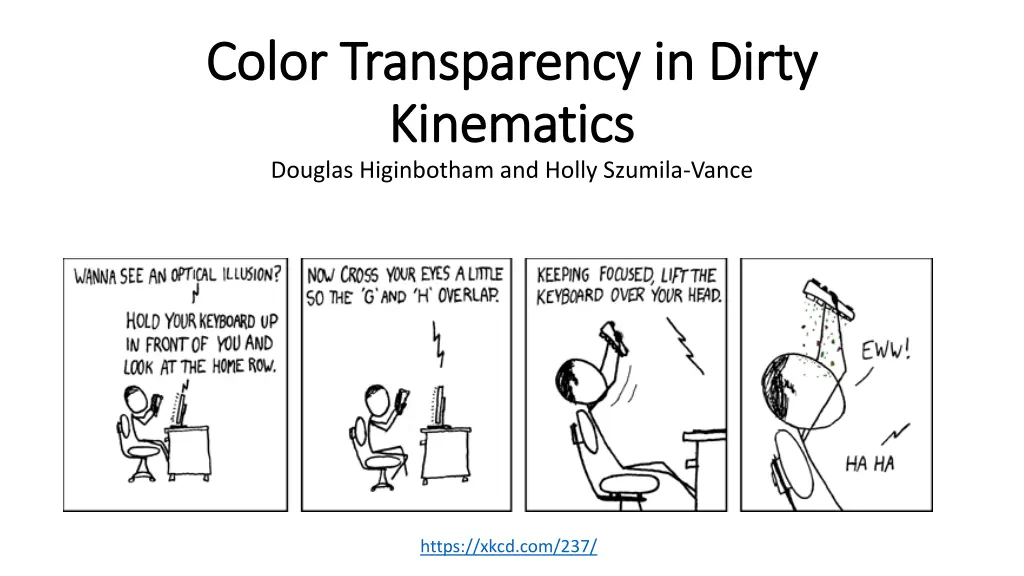
Color Transparency in Kinematics Research
Investigate the effects of color transparency in nuclear physics through experimental and theoretical models, exploring various kinematics patterns and their impact on yield predictions and nucleon behavior. Utilize data from low to high Q2 scans, comparing dirty and clean kinematics to enhance understanding of initial-state effects and nucleon re-scattering dynamics.
Download Presentation

Please find below an Image/Link to download the presentation.
The content on the website is provided AS IS for your information and personal use only. It may not be sold, licensed, or shared on other websites without obtaining consent from the author. If you encounter any issues during the download, it is possible that the publisher has removed the file from their server.
You are allowed to download the files provided on this website for personal or commercial use, subject to the condition that they are used lawfully. All files are the property of their respective owners.
The content on the website is provided AS IS for your information and personal use only. It may not be sold, licensed, or shared on other websites without obtaining consent from the author.
E N D
Presentation Transcript
Color Transparency in Dirty Color Transparency in Dirty Kinematics Kinematics Douglas Higinbotham and Holly Szumila-Vance https://xkcd.com/237/
Data Yield / Predicted Yield from Naive Model Need to check if the denominator of this point is the same as the rest. Transparency was extracted as the ratio of experimental yield to the PWIA yield integrated over the same phase space volume https://doi.org/10.1103/PhysRevLett.126.082301
Classic (NIKHEF/SACLAY) Low Q2 A(e,ep) Scattering Results Independent-Particle Shell-Model is based upon the assumption that each nucleon moves independently in an average potential (mean field) induced by the surrounding nucleons SPECTROSCOPIC STRENGTH The (e,e'p) data for knockout rate is 60 70% of the mean field prediction. We now know that that reduction is mostly due to initial- state effects (i.e. short-range and long-range correlations) NOTE: I thought it was curious that the very low Q212C point has the same value as the extreme high Q2 result from Hall C though denominators not the same. Target Mass
Going to higher and higher Q2 obtaining same ratio From a simple minded experimentalists point of view this simple means the reduction in the ratio is an initial-state effect. NOTE: From classic NIKHEF (e,e p) data one would expect the constant Transparency magnitude to change with the shells (i.e. Em cut) The definition of insanity is doing the same thing over and over again, but expecting different results. Albert Einstein Now we don t doing exactly the same thing, but perhaps it is worth thinking about another kinematics.
Repeat Q2 scan in dirty FSI dominated kinematics q-vector q-vector q-vector Proton detector Proton detector Proton detector A simple cartoon where at some Q2 the FSI re-scattering stops as the proton becomes transparent. We know FSI dominated kinematics can give an order of magnitude larger cross sections that pure PWIA
Summary New Hall C CT (e,e p) Experiment has not seen CT to a Q2 of 14.2 GeV2 The kinematics for that run were relatively clean and compared to a simple model To try to enhance any possible accessible (e,e p) CT signal in accessible kinematics, we are investigating making use of dirty FSI dominated kinematics For the SRC (e,e p) experiments we spend MANY years to minimize FSI, MEC, etc. From those studies we know exactly where to go for FSI dominated kinematics In dirty kinematics go from low Q2 to high Q2 taking a ratio to a FSI model without CT Hall C (e,e p) two spectrometer experiment experiment (this part is easy) Still in VERY early stages of looking into this idea and calculations At this point, I think the null hypothesis would be no 12C(e,e p) CT at these Q2, so this is the best we have come up with thus far to try to enhance any possible signal and challenge the null hypothesis.
